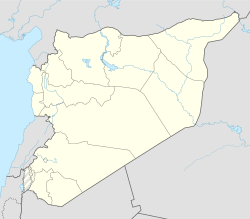Qatana (Arabic: قَطَنَا, romanized: Qaţanā) is a city in southern Syria, administratively part of the Qatana District of Rif Dimashq Governorate. Qatana has an altitude of 879 meters. According to the Syria Central Bureau of Statistics, the city had a population of 33,996 in the 2004 census. It is the administrative center of the Qatana Subdistrict, which contained 20 localities with a collective population of 147,451 in 2004.
Qatana
قَطَنَا | |
|---|---|
 General view of Qatana, 1867–1914 (late Ottoman period) | |
| Coordinates: 33°25′54″N 36°5′33″E / 33.43167°N 36.09250°E | |
| Country | |
| Governorate | Rif Dimashq |
| District | Qatana |
| Subdistrict | Qatana |
| Settled | c. 880 |
| Elevation | 879 m (2,884 ft) |
| Population (2004 census)[1] | |
• Total | 33,996 |
History
editIn the early 13th-century, during Ayyubid rule, Yaqut al-Hamawi noted Katana as "one of the villages of Damascus".[2] Tamerlane camped at Qatana during the siege of Damascus in 1400–1401;[3] hence, the region was called as "Wadi al-Ajam" afterwards.
In 1838, it was noted as a predominantly Sunni Muslim village.[4]
In October 1947, the Syrian army began using Qatana as a training camp in preparation for a conflict in Palestine.[5]
Syrian sources relayed to Reuters that on December 10, 2024, following the swift offensive attack and government takeover by Hayat Tahrir Al Sham, Israeli forces entered the demilitarized zone and later reached the town, 10 kilometres (6.2 mi) inside Syria and 25 kilometres (16 mi) from Damascus. The claim was denied by Israeli Defense Minister Israel Katz.[6][7]
Geography
editClimate
editQatana has a cold semi-arid climate (Köppen climate classification: BSk). Rainfall is higher in winter than in summer. The average annual temperature in Qatana is 16.1 °C (61.0 °F). About 296 mm (11.65 in) of precipitation falls annually.
| Climate data for Qatana | |||||||||||||
|---|---|---|---|---|---|---|---|---|---|---|---|---|---|
| Month | Jan | Feb | Mar | Apr | May | Jun | Jul | Aug | Sep | Oct | Nov | Dec | Year |
| Mean daily maximum °C (°F) | 10.9 (51.6) |
12.6 (54.7) |
16.1 (61.0) |
20.9 (69.6) |
26.5 (79.7) |
30.9 (87.6) |
32.8 (91.0) |
33.5 (92.3) |
30.2 (86.4) |
25.8 (78.4) |
19.0 (66.2) |
13.3 (55.9) |
22.7 (72.9) |
| Mean daily minimum °C (°F) | 2.0 (35.6) |
2.6 (36.7) |
4.8 (40.6) |
8.0 (46.4) |
11.6 (52.9) |
14.9 (58.8) |
16.5 (61.7) |
16.8 (62.2) |
14.4 (57.9) |
11.4 (52.5) |
7.2 (45.0) |
3.9 (39.0) |
9.5 (49.1) |
| Average precipitation mm (inches) | 73 (2.9) |
55 (2.2) |
33 (1.3) |
16 (0.6) |
11 (0.4) |
0 (0) |
0 (0) |
0 (0) |
0 (0) |
11 (0.4) |
35 (1.4) |
62 (2.4) |
296 (11.7) |
| Source: Climate-Data.org, Climate data | |||||||||||||
References
edit- ^ General Census of Population and Housing 2004. Syria Central Bureau of Statistics (CBS). Rif Dimashq Governorate. (in Arabic)
- ^ Le Strange, 1890, p. 483
- ^ Ibn Khaldun 1952, p. 57.
- ^ Smith, in Robinson and Smith, 1841, vol 3, 2nd appendix, p. 148
- ^ Morris, Benny (2008). 1948: A History of the First Arab-Israeli War. New Haven: Yale University Press. p. 68. ISBN 978-0-300-12696-9.
- ^ "Israeli military incursion in Syria reaches 25 km southwest of Damascus: Reuters". LBCIV7. Retrieved 2024-12-10.
- ^ Mackenzie, Al-Khalidi, James, Suleiman (2024-12-10). "Israel says it will impose 'sterile defence zone' in southern Syria". Reuters. Retrieved 2024-12-10.
{{cite web}}: CS1 maint: multiple names: authors list (link)
Bibliography
edit- Ibn Khaldun (1952). Ibn Khaldūn and Tamerlane: Their Historic Meeting in Damascus, 1401 A.d. (803 A. H.) A Study Based on Arabic Manuscripts of Ibn Khaldūn's "Autobiography,". Translated by Walter Joseph Fischel. University of California Press.
- Le Strange, G. (1890). Palestine Under the Moslems: A Description of Syria and the Holy Land from A.D. 650 to 1500. London: Committee of the Palestine Exploration Fund. OCLC 1004386.
- Robinson, E.; Smith, E. (1841). Biblical Researches in Palestine, Mount Sinai and Arabia Petraea: A Journal of Travels in the year 1838. Vol. 3. Boston: Crocker & Brewster.
